|
|
|
Animals .. Our second most valuable resource
|
 |
|
All good things are wild and free.
--Henry
D. Thoreau
They fly, crawl, walk, swim, swing, creep, hop and slither. From insects to whales, each and every animal has a
purpose on this earth. Whether you think they are cute and cuddly, or slimy and gross ... each and every animal has
a right to some protection. Snake or dolphin ... wolf or lion ... monkey or panda ... chicken or crocodile, each is
beautiful and most are largely misunderstood, but most importantly ... each is IMPORTANT! Mother nature has a delicate
balance on this planet, and the animal species figures greatly into her plan. Please educate yourself about the animals
in your area, find out what to look out for and how to avoid wild animals. A great website that can show you what species
are native right in your own backyard is http://www.enature.com They don't look to hurt you, they don't want to hurt you ... you don't have to hurt them. Also, take a look at
the wildlife habitat. Most conflicts between human and animal come from loss of habitat. The animals are losing
thier homes ... they don't have any where to go! When we cut down trees, or pollute streams and rivers, where are the
thousands of creatures who live there supposed to go? We need animals. Click on the WWF site below to take a look
at a partial listing of the endangered species in this world, we all have to do something ... soon!

In The Animal Rescue Site's first year, they gave 22.9 MILLION bowls of food to formerly abused and abandoned animals
currently living in shelters or sanctuaries.
You can help them give even more food and care to even more animals in thier second year by clicking daily and
telling friends about this fast, free way to help animals. It's simple: The number of animals
helped depends on the number of people who click on the "Feed an Animal in Need" button. More clicks mean more food!
Please visit and feed an animal http://www.theanimalrescuesite.com/

It's all connected. Saving one species or habitat benefits countless others.
Visit http://www.nwf.org to learn about conservation efforts, and what actions you can take from your very own home!
Did you know that there are tens of thousands of animals on the endangered species
list? That if things continue as they are, by the year 2025 the earth WE could lose one fifth of all the animal
species we know of today? Why? Some of the top threats are habitat destruction by unsustainable logging and human
settlement; pollution of water, soil, and air by toxic chemicals; unnatural climate changes due to fossil fuel use; unmanaged
fishing that exhausts fish stocks; and illegal hunting to supply the demand for skins, hides, traditional medicines, food,
and tourist souvenirs! This means we CAN stop this! Please take a look at a partial list of the endangered
species, as of June 1999. http://www.worldwildlife.org/news/pubs/specieslist.html
| Grizzly Bear |
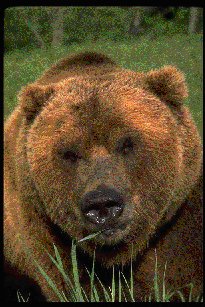
|
Status: Endangered
Grizzlies range in color from white, blonde, brown, black
and shades thereof. The tips of most fur are lighter in color giving them a grizzled
effect hence the name. Grizzly bears feed on berries (blueberries, bearberries,
etc.), roots, bulbs of plants, ground dwelling rodents, and most importantly whitebark pine nuts. Sometimes grizzlies will locate a cache of these nuts that a ground squirrel has stored for the winter. With their excellent sense of smell, grizzlies can locate carrion from miles away
and will readily feed on it. Females reach their maximum weight of 270 to 770
pounds in 8 years. Males reach their maximum weight of 330 to 1150 pounds in
12 years. In general, bears will
flee as soon as they detect humans. Finding food,
finding mates, and avoiding being preyed upon govern a brown bears life.
|
 |
 |
 |
 |
 |
 |
|
Let Nature be your teacher.
--William
Wordsworth
| African Lion |
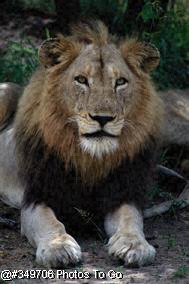
|
Status: Protected
Lions are shot as vermin in some parts of Africa. Lion populations in general are healthy
in most of their present range. However, poaching, and the constant demand for more farmland will threaten this status in
the future. The lion is the only big cat that is not considered an endangered species. (Asiatic lion excepted.)
In 1994, canine distemper- introduced accidently by man- wiped out a third of the Serengeti's lions. In South Africa,
Tubercelosis is now threatening to wipe out many lions. Unlike canine distemper, tubercelosis can be carried naturally in
some lion prey species (Namely Cape Buffalo) and will be much harder to control.
The mature male lion
has a mane that covers the backside of the head, and the shoulders. The extent of the mane varies from individual to individual,
with some having no mane at all, while others have a luxurious mane that runs onto the body and along the abdomen. The mane
varies in color from the rest of the body, and tends to grow darker with age. Young lions have leopard like markings. A pride
usually consists of 4-12 related adult females, their offspring and 1-6 adult males. Females
do most of the hunting. A roar can be heard 5 miles away. They can reach speeds of 36 mph.
India
has a small population of the Asiatic lion. The 250 or so members of this group are all that remain of the lions that once
roamed all of the Middle East and Asia. Asiatic lions are a bit smaller than their African counterparts, and the males
tend to have scruffier manes.
| Plains Zebra |
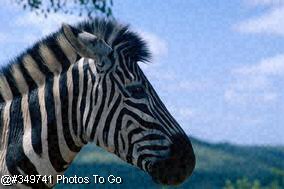
|
Status: There are three species of Zebra. The Grevy's Zebra,
largest of the three is extinct in Somalia, and endangered elsewhere in thier range due to poaching and habitat destruction.
The Mountain Zebra is endangered and the Plains Zebra is still plentiful.
Zebras are a special group of horses. These are herd animals.
Adults live in groups consisting of a male and a few females, each group with a home range. Surplus males live in bachelor
herds. The groups are made up of nonrelated adults since both sexes leave their natal area. Each individual stripe pattern
is different. The skin is black, even under the white hair. Zebra are normally 4 to 5 foot tall, 7 to 9 foot long and weigh
500 to 1300 pounds when full grown.
| African Elephant |
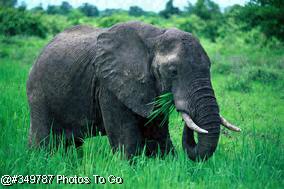
|
Status: Endangered
Although poaching of elephants for
their ivory has declined since the 1989 "ivory ban", it remains a widespread problem in West and Central Africa, and recently
seems to be increasing elsewhere. A more long-term threat to the species, however, is the reduction of habitat available to
elephants in the face of expanding human populations.
The African Elephant is the largest
of all land animals and also has the biggest brain of any land animal. The adult male is much larger than the adult female.
Head and body length including trunk is 19-24 feet. Height averages 10-13 feet. African Elephants can Weigh 5.5 - 7
tons. Both males and females have ivory tusks. Elephants are also wonderful swimmers. Elephants live in a complex matriarchal
society normally composed of 8 to 15 related members and led by a dominant cow. Man is the only real enemy of the elephant.
| Bottlenose Dolphin |
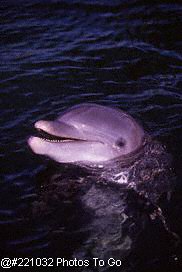
|
Status: Vulnerable (to
commercial fishing practices and ocean pollution)
The dolphin is considered the most intelligent animal of the
aquatic environment, and among the most intelligent animals on the planet. Dolphins are large brained, air breathing mammals
which nurse their young. They are not fish. Dolphins actively chase their prey and often hunt in groups. A school of dolphins
usually consists of around 12 to 30 dolphins. The bottlenosed dolphin swims at a relatively low speed of around 7-8 mph and
dives as deep as 333-498 ft. The bottlenosed dolphin is classified as a toothed
whale. They are excellent hunters. They use sound waves to "see" their environment and where they are going through a process
known as echolocation, by which acoustical "clicks" reverberate back to the dolphin, giving it a very clear picture of its
surroundings. It is well known that dolphins can see inside the bodies of their fellow dolphins, and other animals
in the water. This is because dolphin sonar evolved to pass through water and does not reflect until it hits something like
bone or air sacs. Since animal bodies are more than 50% water, their sonar enables them to literally "see" inside other animals.
It is possible that dolphins can read the emotion of other dolphins. Bottlenose dolphins from the Atlantic Ocean can
reach an average of 8 to 9 feet in length and weigh between 400 and 575 pounds. The Pacific bottlenose can reach
12 feet and weigh and average of 1000 pounds.
| Reef Shark |
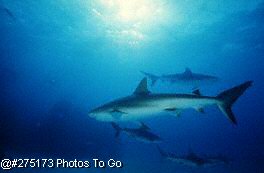
|
Status: Vulnerable
There are more than 350 known species of sharks among the eight
main groups. The biggest shark is the whale which can be up to 50 feet long, the smallest sharks are Dwarf Lanternfish
which are 6 to 8 inches long. The Blue shark had been known to migrate from 1,200-1,700 miles in a seasonal journey
from New York state in the USA to Brazil. The Reef Shark shown above, are found in the Red Sea and East Africa
to the Hawaiian Islands and the Tuamotu Archipelago, also the eastern Mediterranean. They are regularly caught by inshore
fisheries and vulnerable to depletion because of its small litter sizes and long gestation periods. Also as a
food source they are generally marketed fresh (as fillet), and may be dried, salted, smoked or frozen. The fins are valued
for shark-fin soup; the liver as a source of oil.
| Harbor Seal |

|
Status: Threatened
There are 18 seal species still inhabiting the seas today, but not
long ago there were 19 species. Seals can be found in all the oceans and a few freshwater lakes, one of which is Lake
Baikal in Russia. The Caribbean monk seal was last sighted in 1952 and is now listed as extinct. One of the seal
species on the endangered species list is the Hawaiian monk seal.
The largest seal is the Elephant Seal, which can weigh more than
5,000 pounds, the smallest is the Ringed Seal at 110 pounds. Seals do not have an ear that extends from the skull, but
they can still hear well.
| Peafowl |
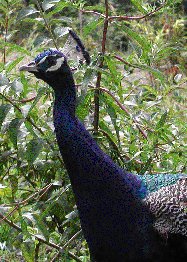
|
Status: Protected
The peafowl is the largest member of the pheasant and turkey family.
Although commonly called peacocks, this term is property applied only to the male peafowl. Female peafowl are called peahens.
There are two species of peafowl found in the wild, the Indian Peafowl and the Green Peafowl. The average male body length
is 3 to 4 feet and the 'tail' length is 4 to 5 feet. Females are considerably smaller with a body length of 2.5 to 3.5 feet.
Males weigh from 9 to 13 lbs., and females weigh between 6 and 9 lbs. The male peafowl (peacock) has a long train tail)
of green and bronze feathers adorned with blue-green spots that look like eyes. An average peacock train contains more than
200 feathers. The train, when fanned out in a courtship display, is supported by 20 shorter tail feathers. The main
function of the peacock's train is for courtship displays. The train often provides a defense mechanism, as well; inexperienced
predators attempting to catch a peacock sometimes pounce on the long train rather than the bird's body. Thankfully,
the export of peacock train feathers from India is now illegal.
| Timber Wolf |

|
Status: Endangered
Human intolerance for wolves has led to masses of wolves being shot,
trapped and poisoned. Wolf populations are constantly pressured by the loss of habitat from land clearing, drainage projects,
logging, mining, and road development. Wolves have few natural enemies. Territorial by nature, they have been known
to kill other wolves that have been caught trespassing within their region. But essentially, the greatest threat to a wolf's
survival is people. Wolves are very shy of humans, and avoid them whenever possible. There has never been a documented
fatal attack of a human by a healthy, wild wolf in North America. The gray wolf is one of two types of wolves in the
U.S. The others is the red wolf.
| Polar Bear |

|
Status: Protected
Polar bears are a potentially
threatened species that live in the circumpolar north. They are animals that know no boundaries. They pad across the ice from
Russia to Alaska, from Canada to Greenland and on over to Norway's Svalbard archipelago. Polar bears are the world's
largest land predators. Adult male bears weigh from 775 to more than 1,500 pounds. Females are considerably smaller, normally
weighing 330 to 550 pounds. It's stomach can hold more than 150 lbs of food. The polar bear's fur is water repellant and the
individual hairs are clear due to hollow hair shafts. Despite what our eyes tell us, a polar bear's fur is not white. Each hair shaft is pigment-free and transparent with a hollow core.
Polar bears look white because the hollow core scatters and reflects visible light, much like ice and snow does. When photographed
with film sensitive to ultraviolet light, polar bears appear black. The
feet of the polar bear serve as snow boots and as paddles when they are in the water. Polar
bears travel great distances every year. They are champion swimmers, and have been known to swim more than 60 miles without
a rest. Polar bears have been clocked swimming as fast as six miles per hour.
| Red Fox |
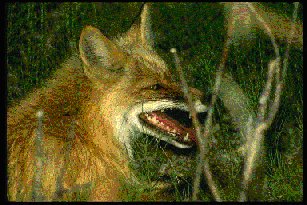
|
Status: There are 21 known species of Fox. Currently none
are endangered. =)
The Red Fox (shown above) is common in most of northern North America.
It is found throughout Alaska, except for some of the islands of Southeast Alaska, the western Aleutians, and Prince William
Sound. It is native to Kodiak Island but is an introduced animal on many islands in the state as a result of fox farming operations
in the early 1900s. Foxes are members of the dog family Canidae, and their general appearance is similar to dogs, wolves,
and coyotes. The red fox measures 22 to 32 inches head and body length, and the tail is 14 inches to 16 inches long.
The adult fox weight is from 6 to 15 pounds.
| Giant Panda |

|
Status: Endangered
There are two kinds of Pandas. The giant white and black Panda (shown
above with her baby) is the one that comes to mind for most of us. But, there is also the Red Panda which is also called the
lesser Panda. Both are endangered.
Pandas are only found in a relatively small area in Asia. They date
back 2 to 3 million years. Ancient chinese history and writings abound with mention of the Panda. They were kept by emperors and their hides were highly
valued. They carried a mystique and were believed to be able to ward off evil spirits and natural disasters. Pandas
live in and around mountainous slopes and exist on a diet largely comprised of bamboo shoots. The Giant Panda is white
and black. An adult can grow to 3 1/2 to five feet and weigh up to 350 pounds. In the wild, adult female pandas give birth
once a year and usually produce two cubs in the litter. A newborn cub will weigh around 5 ounces is all white and blind at
birth. The black spots develop after about a month. The Red Panda is reddish brown in color. It grows to about two feet
and weighs six to twelve pounds. The Red Panda also lives in China and Tibet. In addition, it can be found in Burma, India
and Nepal. While the Giant Panda sticks mostly to the ground, the Red Panda spends a lot of time in the trees. It's diet is
broader. While it eats bamboo, it also consumes acorns and roots.
|
|
|
|
| Leopard |
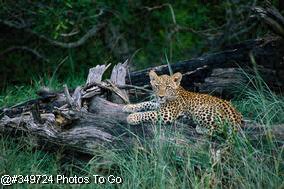
|
Status: Threatened
Although no other wild cat has such a wide spread range and
diverse prey base as the leopard, it is still under threat in many regions. Once common in all parts of Africa apart from
the deserts of the Sahara, it has now gone from most parts of northern Africa, apart from a few widespread areas of the Atlas
mountains and is scarce in the extreme west of the continent. Subspecies of the leopard once common in the middle east are
now all but extinct, as is the Persian leopard. In south east Asia and India its numbers have dwindled mainly due to
hunting for its prized fur and through loss of natural habit due to the spread of the human population. The Korean Leopard are
extremely rare in the wild, suffering extensively from habitat loss. The Snow Leopard are also endangered, and extremely rare in most of their range due to the demand for skins. Although
trade in snow leopard furs is illegal, it continues, threatening the snow leopard's existence. An estimated 3,000-10,000 are
left in the wild, and about 370 are in captivity.
| Nile Monitor |
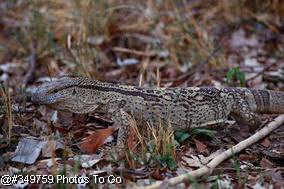
|
Status: There are currently over 4,675 lizard species including
24 monitor species, many of which are endangered.
The Monitor lizard, shown above, is found in most of Africa, Southern
Asia, the Malay archipelago and Australia. Some species can grow up to 10 feet in length and weigh up to 350 pounds.
Monitors are a versatile group of predatory lizards arising from stock similar to that which produced the snakes. Most
species can run, burrow, swim and climb. The snake-like body is supported by strong legs, each equipped with 5 well developed
claws which aid in burrowing, climbing and defense. A protective bony sheath encasing the brain enable the monitors to swallow
large prey without damaging the brain. Their teeth are long, sharp and backwardly curved. The long, whip-like tail has no
fracture point and there is no regeneration. It is used both as offense and defense and as the propelling force when swimming.
| Chimpanzee |
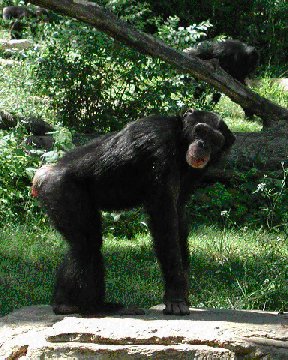
|
Status: Endangered and still declining rapidly
Chimpanzees used to live throughout equatorial Africa, this is an
area almost the size of the United States and includes 25 countries. Today, chimpanzees are extinct in 4 of them, and are
down to such low numbers in 5 more that their disappearance is inevitable. Another 5 countries have small, scattered populations
of a few hundred. The primary threats to chimpanzees are habitat destruction and hunting.
Chimpanzees are incredibly intelligent and expressive animals.
Chimpanzees communicate with each other through a complex system of sounds, gestures, body postures and facial expressions.
From fear and anger to joy or excitement - chimpanzees make it pretty clear what they are feeling. Probably no other facet
of chimpanzee behavior has received more notice than the manufacture and use of tools. Tool use includes pounding of nuts
and hard shells with sticks and stone hammers, probing for honey and insects with twigs and grass stalks, poking at unfamiliar
items with sticks, prying open ant nests with small branches, and sponging water from hollow trees with wads of crumpled leaves.
Chimpanzees are our closest living relative because we share all but 1.4% of our DNA. There are approximately 2,400 chimpanzees
in the United States. 1,700 of these chimps are used for biomedical testing, 500 live in zoos, and about 200 are used for
entertainment. Chimpanzees can live for more than 50 years.
For more information on the plight, and what you can do to help save our closest living relative, please visit http://www.savethechimps.org/
| Manatee |
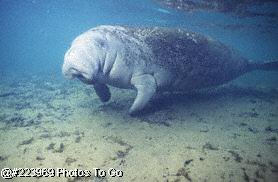
|
Status: Endangered
A recent review of the future risks of the manatee population
by scientists at the Florida Fish and Wildlife Conservation Commissions Florida Marine Research Institute determined that
we could lose as much as half of the existing manatee population over the next 45 years. If we dont adopt more protective
regulations in areas where manatees are being killed by boats, this species will not be recovered in our lifetime or even
the lifetime of our grandchildren. There are approximately 3,000 West Indian manatees left in the United States.
The
manatee are closely relatated to the elephant and the hyrax, a small, gopher-sized mammal. The average adult
manatee is about 9.8 feet long and weighs between 800-1,200 pounds. Manatees are gentle and slow-moving. Most of their
time is spent eating, resting, and in travel. Manatees are completely herbivorous. They eat aquatic plants and can consume
10-15% of their body weight daily in vegetation. They graze for food along water bottoms and on the surface. They may rest
submerged at the bottom or just below the surface, coming up to breathe on the average of every three to five minutes.
West Indian manatees have no natural enemies, and it is believed they can live 60 years or more.
| Walrus |
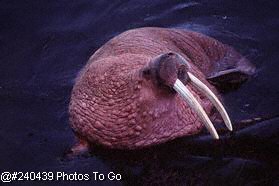
|
Status: Endangered
Over-exploitation by commercial hunters
has endangered the species throughout its range. The population has improved in the north Pacific, but those in the north
Atlantic remain threatened.
Tusks are used as weapons against
rivals during the breeding season, as a status symbol in the herd and as ice picks. Walruses' blubber (fat) may be as much
as 6 inches thick. The walrus turns red when it sunbathes. The heat causes its arteries to enlarge, and the blood rushes to
the skin. Obobenidae, the walrus' family name, comes from the Greek word that means "one who walks with his teeth."
The walrus can dive as deep as 250 feet for up to 10 minutes. The sensitive bristles of the walrus' mustache are used to locate
food.
| White Tiger |
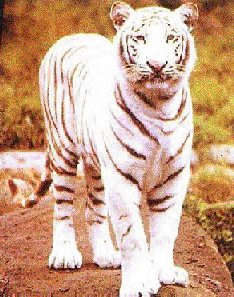
|
Status: Endangered
The tiger is the largest
member of the feline family. There are 8 species of tiger, 3 of which have become extinct in the last 50 years!
The Siberian tiger is the largest of all living tigers. Adult males average 9-11 feet in length and weigh between 450 and
600 pounds while adult females average 8-9 feet in length and weigh between 250 and 400 pounds.There are currently more Siberian
tigers in zoos than in the wild. The South China tiger is found in central and eastern China. It is estimated that at
most only 20-30 South China tigers still exist in the wild. Currently 47 South China tigers live in 18 zoos, all in China.The
South China tiger is the most critically endangered of all tiger subspecies. The South China tiger is one of the smallest
tiger subspecies. Male tigers measure about 8 feet from head to tail and weigh approximately 330 pounds. Female tigers are
smaller, measuring about 7 1/2 feet long. They weigh approximately 240 pounds. The Indochinese tiger is centered in
Thailand, and also found in Myanmar, southern China, Cambodia, Laos, Vietnam, and peninsular Malaysia. Indochinese tigers
are a bit smaller and darker than Bengal tigers, with shorter, narrower stripes. Males average 9 feet from head to tail and
weigh about 400 pounds. Females are smaller, measuring 8 feet in length and weighing approximately 250 pounds.
White Tigers (shown above) are a color variant of Bengal tigers and are rarely found in the wild. Most Bengal
tigers live in India in a wide range of habitats. Male Bengal tigers average 9 1/2 feet from head to tail and weigh
about 480 pounds. Females, about 8 feet in length and weigh approximately 300 pounds. The Sumatran tiger is found only on
the Indonesian island of Sumatra in habitat that ranges from lowland forest to submontain and montain forest with some peat-moss
forest. About 400 wild Sumatran tigers are believed to exist, primarily in the island's five national parks. 210 captive animals
live in zoos around the world. Sumatran tigers are the smallest tiger subspecies. Males average 8 feet in length from
head to tail and weigh about 264 pounds. Females measure approximately 7 feet in length and weigh about 198 pounds. The stripes
on the tiger's face are similar to a human thumbprint, there are no two tigers with exactly the same stripe pattern. The only
enemy of the tiger is the human, and the tiger is threatened by hunting and depletion of their habitat. Largely
a solitary animal. Tigers stalk and kill prey alone. They have large and clearly marked territories. They are excellent swimmers.
| Komodo Dragon |
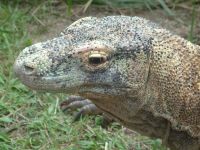
|
Status: Endangered
The Komodo Dragon is the largest living lizard. They only
inhabit a small group of islands in the Indonesian Archapelego. Most lizards are plant eaters, but not Komodo dragons.
Dragons are meat eaters. The dragons bite contains deadly bacteria that will eventually kill its intended prey. Soon
other dragons will join in on the feast, fighting over the best pieces. The dragon can consume up to 80% of its body weight
during one meal. In the wild, there are four times as many male dragons as there are females.
| Red Kangaroo |
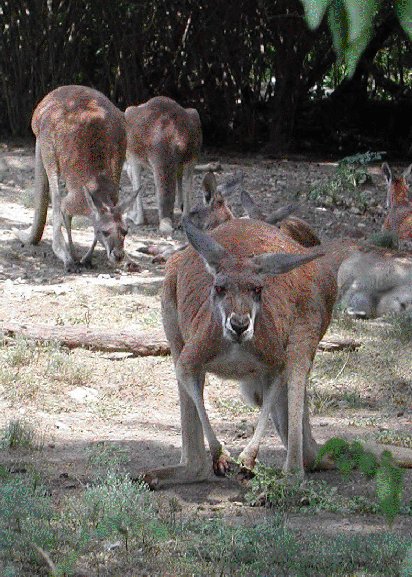
|
Status: Threatened
The Red Kangaroo is the largest marsupial
and can hop as fast as 40 mph. These animals have large feet, roughly 18 in, and a tendon in their leg that acts like a rubber
band, allowing them to use less energy as they move faster. The Red Kangaroo usually eats at night. They are a social
animal, and form mobs which frequently change members. They rest in shaded bush areas during midday. The kangaroo uses
its tail to keep balance while jumping
| Baboon |
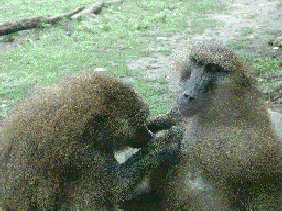
|
Status: Doing well! =)
Baboons, like most primates are very intelligent and expressive.
Baboons have complex social structures with anywhere from 8 to 200 individuals per troop. They use at least 10 different vocalizations
to communicate. When traveling as a group, males will lead; females and young stay safe in the middle and less dominant
males bring up the rear. Baboons reach a length of 24-29 inches in head and body, and thier tail length runs 22-34
in. Females weigh an average of 35 pounds while males can weigh 59-97 pounds. Baboons live about 20-30 years.
| Banded Snake |

|
Status: Varied, some endangered
There are approximately 2500 different
species of snakes, 20% of which are poisonous. The largest snakes in the world are members of the family Boidae, which
includes the boa and the python. Some members of this family never attain a length of more than 2 ft, but the largest may
grow to more than 30 ft. The big pythons can eat animals that weigh up to about 150 lb, but swallowing such a meal is
a difficult process. The smallest snake the Lesser Antillean Threadsnake is so small that it could slither through
a pencil if the lead were removed. Vision is well developed in most snakes, but many burrowing
snakes are virtually blind. Snakes have a strong sense of smell, which is relied on to a large extent in hunting food.
Snakes find their prey by sight and scent, and sometimes temperature. Except for burrowing species, snakes have excellent
short-range vision. Their sense of smell is extraordinary, thanks to a harmless, constantly flicking forked tongue that carries
scent particles to a specialized sensory organ on the roof of the mouth. Snakes are deaf to airborne sounds. They do
not hear, as is sometimes believed. They can, however, feel vibrations. Snakes move slower than an adult human can run;
the fastest recorded speed achieved by any snake is about 8 mph, but very few can go that fast. The
greatest age known for any snake is just under 30 years, attained by both the anaconda and the black-lipped cobra. Most
snakes can only strike about one half their total body length, and will only bite as a last resort, unless hunting.
|
|
 |
 |
|
In the woods is perpetual youth.
--Ralph Waldo
Emerson
|
|
 |
|
 |
 |
 |
 |
 |
 |
|
 |

|
 |
|

Lane
Briant Home
|
|

